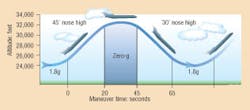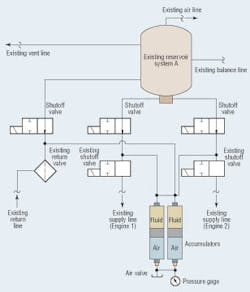If you've always dreamed of becoming an astronaut — and have followed NASA's astronaut training — you're probably familiar with the "Vomit Comet." This KC-135A Stratotanker (a four-engine aircraft similar to a Boeing 707) provides the unique zero-G environment of space flight for test and training purposes by flying in a nausea-inducing parabolic flight pattern. At the top of each slope, the occupants in the open cabin float freely for 30 sec or so (think of it as the funny feeling in your stomach as you crest a hill on a roller coaster). A typical mission is 2 to 3 hr long and consists of 30 to 40 parabolas. Thus, it is not difficult to understand how the KC-135A received its nickname.
Zero Gravity Corp. ("Zero-G") began the flights earlier this year, and promises the experience is better than on the KC-135A. While the NASA flights are research-oriented, Zero-G is quick to point out that their flights are more oriented to passenger comfort and enjoying the experience. The number of parabolas is generally limited to 15 (NASA studies have shown most people don't get sick until more than 15 parabolas), and participants are given a little time between parabolas, to adjust and recover.
Tricky hydraulics
It is important to remember that during the zero-G phase of the parabola, the entire plane including the hydraulics is weightless, not just the passengers. Modifications made to Zero-G's 727 allow for the isolation of the hydraulic reservoir during parabolic flight. This eliminates the possibility of hydraulic pump cavitation and loss of hydraulic pressure. The modification is to the "A" side of the hydraulic system on the Boeing 727-200, which is primarily for flight controls.
The system includes three normally open shutoff valves that are activated by the flight engineer. Moving a switch closes the valves for parabolic flight, isolating the reservoir.
The valve between the reservoir and return line filter is open at all times except during periods of zero-G. It is closed during periods of zero-G, in order to direct return oil to the pump supply line as required by the pumps or to the accumulators. The two valves just below the reservoir are also open at all times except during periods of zero-G. They are closed during periods of zero-g to prevent return oil from going to the reservoir, thereby keeping it confined to the pump supply lines and accumulators.
The hydraulic accumulators are plumbed in parallel with a gage and filler valve on the air side. Prior to installation, the accumulator pistons are positioned to the oil end by pressurizing the air end. The accumulators are installed oil end up and filled with fluid, 2 to 3 in.3 With all components in place and joints and fittings sealed, the air side of the accumulators are serviced with nitrogen to 15 ±3 psig. With the reservoir pressurized to 45 psig from either a nitrogen bottle or engine bleed, the accumulators will contain approximately 100 in.3 of oil.
Zero-G's hydraulic modification was designed for ease of maintenance and simplicity. When the system is not being used for parabolic flight, no special maintenance procedures are needed.
Due to the high-level of involvement by the FAA, all potential problems were anticipated and dealt with in the design — leaving passengers to worry more about their breakfast than the hydraulic controls keeping them safe.
About the Author

Leaders relevant to this article:



